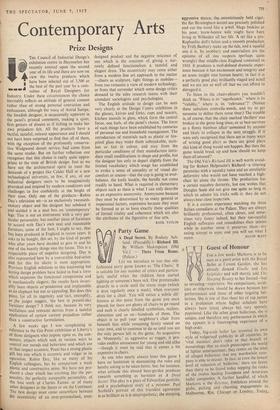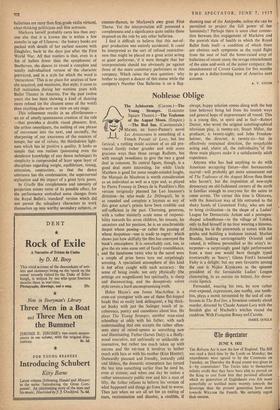Guest of Honour
FOR a few weeks Markova is to be seen as a guest artist with the Royal Ballet at Covent Garden; she has already danced Giselle and Les Sylphicles and will shortly add The Sleeping Beauty to her limited—but so revealing—repertoire. No comparisons, invid- ious or otherwise, should be drawn between her performances and those of other reigning bal- lerinas. She is one of that short list of top names in a profession whose higher echelons have always been (must always be) very sparsely populated, Like the other great ballerinas, she is unique, and therefore any performance in which she appears is a theatregciing experience of a high order. Today, big-scale ballet has invented its own style of Vulgarised publicity in all countries; its `vital statistics' .,don't refer to that branch of numerology that so much preoccupies the world of lighter entertainment; they.centre on the total of alleged ballerinas that any worthwhile com- pany is able to muster. In fact, at even the lowest level of valuation of 'ballerina,' there are fewer than thirty to be found today topping the ranks of the twelve leading European and American ballet companies. A further handful, of which Markova is the doyenne, freelances around the globe, picking and choosing engagements in Melbourne, Rio, Chicago or London. Today,
ballerinas are rarer than first-grade violin virtuosi, clear-thinking politicians and film actresses. Markova herself probably cares less than any- one else that it is known she is within a few months in age of Ulanova : the history books are packed with details of her earliest seasons with Diaghilev, back in the days just after the First World War. All that matters is that, even in a list of ballets fewer than the symphonies of Beethoven, she dances to reveal a complete and totally individualised version of the character portrayed, and in a style for which the word is `miraculous.' This is no place for analysis of how she acquired, and maintains, that style; it came to full realisation during her wartime years with Ballet Theatre in America. For the past twelve years she has been showing a kind of dancing more refined (in the cleanest sense of the word) than anything else now on view on any stage.
This refinement results in an effortlessness— an air of utterly spontaneous creation of the role —that provides, a double visual pleasure; first, the artless smoothness, the melting of one phrase of movement into the next, and secondly, the sharpening of our awareness of the nuances of tempo, her use of rubato, the thistledown light- ness which has so positive a quality. It looks so simple that one realises (possessing even the slenderest knowledge of any dance technique) its simplicity is compounded of layer upon layer of disciplines regardipg.weight, equilibrium, timing, extension, contraction, so that the dance utterance has the condensation, the supernormal stylisation and the impact of a great lyric poem. In Giselle this completeness and intensity of projection misses some of its possible effect, for the performance embodied some changes from t le Royal Ballet's 'standard' version which did not permit the subsidiary characters to work themselves up into worthy secondary subjects, or
counter-themes, to Markova's own great First Theme. Yet the interpretation still possessed a completeness and a significance quite unlike those imposed on the role by any other ballerina.
I find it difficult to believe that this out-of- gear production was entirely accidental. It could be interpreted as the sort of refined restrictive- ness that might be placed on a great artist acting as guest performer, 'if it were thought that her interpretations should too obviously jar against those of the more customary performers in this company. Which raises the nice question : why bother to import a dancer of this status while the company's Number One Ballerina is on a flag-
showing tour of the Antipodes, unless she can be permitted to project the full power of her luminosity? Perhaps there is some clear connec- tion between this engagement of Markova and the poorish state of health in which the Royal Ballet finds itself—a condition of which there are obvious such symptoms as the rapid flight from the nest of half the home-raised crop of ballerinas of recent years; the savage retrenchment of the aims and work of the junior company; the abandonment of Covent Garden for five months to go on a dollar-hunting tour of America next autumn.
A. V. COTON



































 Previous page
Previous page